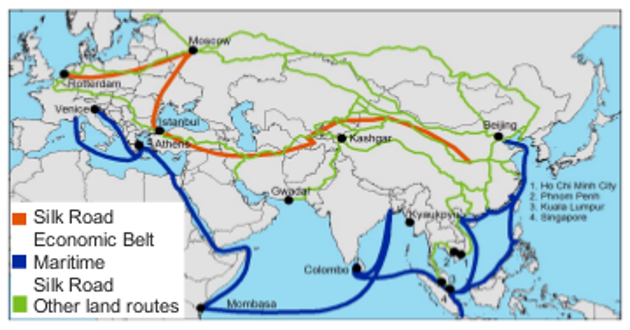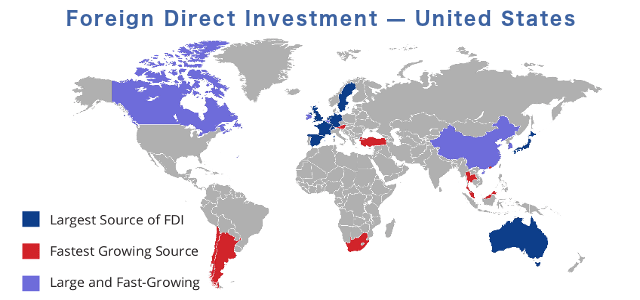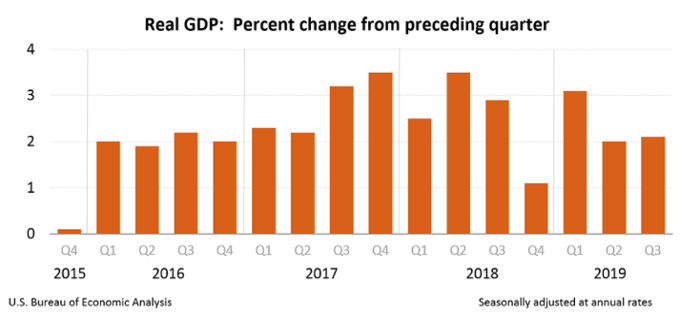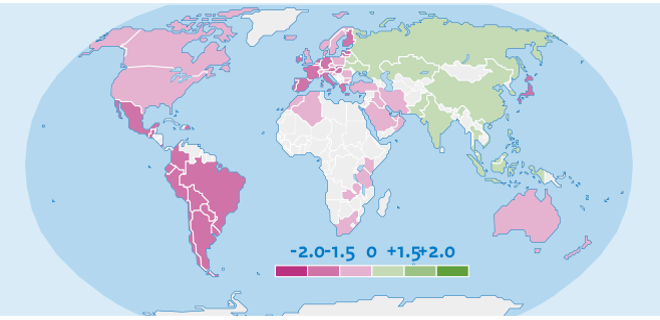An Interconnected & Interlinked World
of Business, Trade, and Commerce.
of Business, Trade, and Commerce.
US Global Trade & Top Trading Partners
International Trade Data Analysis—Trends & Indicators
—Year-to-Date—
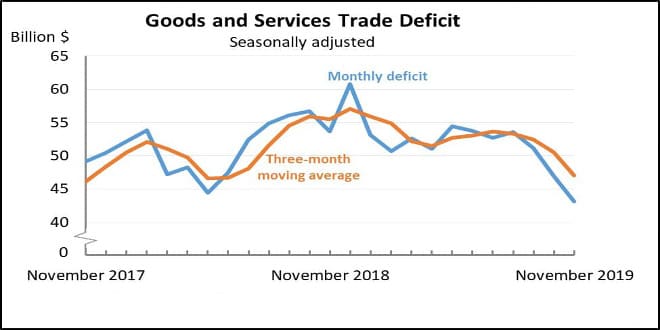
Source: U.S. Census Bureau/U.S. Bureau of Economic Analysis
Since hitting the peak in November 2018, U.S. global trade deficit in goods and services has been on the decline.It was when the effects of the United States’ Trade Wars and Tariffs started biting into not only the US trade, but also the Global trade.
With a population of roughly 320 million people, the United States constitutes less than 5 percent of the world’s population, but Americans get the share of more than 20 percent of the world’s total income. Understandably, The United States is the world’s largest national economy and leading global trader.
But, still, once we take into account the facts that roughly three quarters of world purchasing power and over 95% of world consumers are outside the US, the potential economic gains from trade for the United States are quite easy to recognize. Trade is a major component of US economy. Indicators pointing to the trends in global trade need to be observed closely as they directly effect the national economy and GDP. Since the mid 2018, the trade indicators are giving mixed signals.
Since hitting the peak in November 2018, U.S. global trade deficit in goods and services has been on the decline. But, the overall trade volumes have also been on the decline since hitting the top in May 2018—just before steel and aluminum tariffs went into effect that June.
For the year 2019, both the imports and exports were down. Since then, exports have fallen 2.9%. Imports – particularly in the case of goods, also peaked last year. The sum of exports and imports in 2019 was down 5.5% year-over-year.
Exports were down 0.2% from the year 2018, while imports have declined 0.6% over the same period. On the positive side, this narrowing of trade deficit should provide a modest boost to next quarter’s GDP.
These are the indicators of decline in real purchasing power of the consumers in the US. In such an instance, the demand side of the economy is expected to continue its downward trend. The imports-exports data releases by the office of the United States Trade Representative (USTR) and the U.S. Bureau of Economic Analysis (BEA) over the period since late 2018 points to such overall across the board decline in trade volume.
US Global Trade in Goods With World, Seasonally Adjusted
[All figures are in millions of U.S. dollars on a nominal basis.]
| Month | Exports | Imports | Balance |
|---|---|---|---|
| January 2019 | 137,553.2 | 209,471.5 | -71,918.3 |
| February 2019 | 139,028.9 | 208,905.9 | -69,877.0 |
| March 2019 | 140,563.9 | 212,368.3 | -71,804.4 |
| April 2019 | 136,077.1 | 207,008.6 | -70,931.5 |
| May 2019 | 140,234.2 | 215,035.9 | -74,801.7 |
| June 2019 | 136,449.1 | 210,625.7 | -74,176.6 |
| July 2019 | 137,670.6 | 210,052.8 | -72,382.2 |
| August 2019 | 138,125.7 | 211,148.4 | -73,022.6 |
| September 2019 | 136,155.6 | 206,811.6 | -70,656.0 |
| October 2019 | 135,552.4 | 202,245.6 | -66,693.1 |
| November 2019 | 136,571.1 | 199,558.9 | -62,987.8 |
| TOTAL 2019 | 1,513,982.0 | 2,293,233.2 | -779,251.2 |
Explanatory Notes on the Trade in Goods:
Exports:
Data on U.S. exports of merchandise from the U.S. to all countries, except Canada, is compiled from the Electronic Export Information (EEI) filed by the USPPI or their agents through the Automated Export System (AES). The EEI is unique among Census Bureau data collection methods since it is not sent to respondents soliciting responses as in the case of surveys. Each EEI represents a shipment of one or more kinds of merchandise from one exporter to one foreign importer on a single carrier.
The United States is substituting Canadian import statistics for U.S. exports to Canada in accordance with a 1987 Memorandum of Understanding signed by the Census Bureau, U.S. Customs and Border Protection, Canadian Customs, and Statistics Canada. Similarly, under this Memorandum of Understanding, Canada is substituting U.S. import statistics for Canadian exports to the United States. This data exchange includes only U.S. exports destined for Canada and does not include shipments destined for third countries by routes passing through Canada or shipments of certain grains and oilseeds to Canada for storage prior to exportation to a third country. These shipments are reported on and compiled from EEIs.
Imports:
Published data on U.S. imports of merchandise is compiled primarily from automated data submitted through the U.S. Customs’ Automated Commercial System. Data are also compiled from import entry summary forms, warehouse withdrawal forms and Foreign Trade Zone documents as required by law to be filed with the U.S. Customs and Border Protection. Data on imports of electricity and natural gas from Canada are obtained from Canadian sources.
US Top Trading Partners
The following tables present Year-to-Date Trade Data for the Top 15 US Trading Partners. These top 15 trading partners contribute almost 75% of the total US trade. Combined with the historical data, it serves to show the trend in the coming months and quarters.
[Data are goods only. In Billions of US Dollars]
Year-to-Date Total Trade
| Rank | Country | Exports | Imports | Total | % of Total Trade |
|---|---|---|---|---|---|
| — | Total: All | 1,509.9 | 2,296.0 | 3,806.0 | 100.0% |
| — | Total: of 15 | 1,065.1 | 1,800.8 | 2,865.9 | 75.3% |
| 1 | Mexico | 237.3 | 330.5 | 567.8 | 14.9% |
| 2 | Canada | 270.6 | 292.4 | 563.0 | 14.8% |
| 3 | China | 97.8 | 418.6 | 516.3 | 13.6% |
| 4 | Japan | 67.9 | 132.1 | 200.0 | 5.3% |
| 5 | Germany | 55.5 | 116.8 | 172.3 | 4.5% |
| 6 | S. Korea | 51.5 | 70.8 | 122. | 3.2% |
| 7 | U K | 63.6 | 57.6 | 122.3 | 3.2% |
| 8 | France | 34.5 | 53.5 | 88.0 | 2.3% |
| 9 | India | 31.3 | 53.4 | 84.7 | 2.2% |
| 10 | Taiwan | 28.5 | 49.4 | 77.9 | 2.0% |
| 11 | Italy | 22.1 | 52.4 | 74.5 | 2.0% |
| 12 | Netherlands | 46.7 | 27.4 | 74.1 | 1.9% |
| 13 | Vietnam | 10.0 | 60.9 | 70.9 | 1.9% |
| 14 | Brazil | 39.5 | 28.2 | 67.8 | 1.8% |
| 15 | Ireland | 8.3 | 56.7 | 65.1 | 1.7% |
Year-to-Date Exports
| Rank | Country | Exports | % of Total Exports |
|---|---|---|---|
| — | Total: All Countries | 1,509.9 | 100.0% |
| — | Total: Top 15 Countries | 1,114.3 | 73.8% |
| 1 | Canada | 270.6 | 17.9% |
| 2 | Mexico | 237.3 | 15.7% |
| 3 | China | 97.8 | 6.5% |
| 4 | Japan | 67.9 | 4.5% |
| 5 | U K | 63.6 | 4.2% |
| 6 | Germany | 55.5 | 3.7% |
| 7 | S Korea | 51.5 | 3.4% |
| 8 | Netherlands | 46.7 | 3.1% |
| 9 | Brazil | 39.5 | 2.6% |
| 10 | France | 34.5 | 2.3% |
| 11 | Belgium | 32.4 | 2.1% |
| 12 | India | 31.3 | 2.1% |
| 13 | Singapore | 28.8 | 1.9% |
| 14 | Taiwan | 28.5 | 1.9% |
| 15 | Hong Kong | 28.4 | 1.9% |
Year-to-Date Imports
| Rank | Country | Imports | % of Total Imports |
|---|---|---|---|
| — | Total: All COuntries | 2,296.0 | 100.0% |
| — | Total: Top 15 Countries | 1,822.2 | 79.4% |
| 1 | China | 418.6 | 18.2% |
| 2 | Mexico | 330.5 | 14.4% |
| 3 | Canada | 292.4 | 12.7% |
| 4 | Japan | 132.1 | 5.8% |
| 5 | Germany | 116.8 | 5.1% |
| 6 | S. Korea | 70.8 | 3.1% |
| 7 | Vietnam | 60.9 | 2.7% |
| 8 | U K | 57.6 | 2.5% |
| 9 | Ireland | 56.7 | 2.5% |
| 10 | France | 53.5 | 2.3% |
| 11 | India | 53.4 | 2.3% |
| 12 | Italy | 52.4 | 2.3% |
| 13 | Taiwan | 49.4 | 2.2% |
| 14 | Switzerland | 40.4 | 1.8% |
| 15 | Malaysia | 36.7 | 1.5% |
Year-to-Date Surpluses
| Rank | Country | Surplus |
|---|---|---|
| 1 | Hong Kong | 24.1 |
| 2 | Netherlands | 19.3 |
| 3 | UAE | 14.2 |
| 4 | Belgium | 14.0 |
| 5 | Australia | 11.3 |
| 6 | Brazil | 11.3 |
| 7 | Panama | 6.5 |
| 8 | U K | 6.0 |
| 9 | Chile | 4.9 |
| 10 | Singapore | 4.5 |
| 11 | Qatar | 3.5 |
| 12 | Peru | 3.4 |
| 13 | Dom. Republic | 3.4 |
| 14 | Argentina | 2.9 |
| 15 | Guatemala | 2.6 |
Year-to-Date Deficits
| Rank | Country | Deficit |
|---|---|---|
| 1 | China | -320.8 |
| 2 | Mexico | -93.2 |
| 3 | Japan | -64.2 |
| 4 | Germany | -61.4 |
| 5 | Vietnam | -50.9 |
| 6 | Ireland | -48.4 |
| 7 | Italy | -30.3 |
| 8 | Malaysia | -24.9 |
| 9 | Switzerland | -24.2 |
| 10 | India | -22.0 |
| 11 | Canada | -21.7 |
| 12 | Taiwan | -20.9 |
| 13 | S. Korea | -19.3 |
| 14 | France | -19.0 |
| 15 | Thailand | -18.5 |
元 $ € ¥ ₿
Information
Reports & Analysis
To Help Evaluate
The Potentials For
Business
&
Investment
In an Interconnected
World
-
The Belt and Road Initiative & Made in China 2025
Riding high on the fast tracks of the Belt and Road Initiative, Made in China 2025 is rapidly making inroads into the countries... Fierce competition from Chinese companies...
-
MIC 2025 || The Changing Landscape of Chinese Economy
It was in 2015 that China unveiled its Made in China 2025 (MIC 2015) project. Since then, Chinese economy is metamorphosing and changing at a breakneck pace...
-
Top Freight Forwarders by Country
Large scale ‘local area’ Freight Forwarders listed here, through their contacts and arrangements, also provide services on a global scale. Their main strength though lies in...
-
Most of the Top Global Freight Forwarders listed here serve all the major ports across the Globe, and, through relationships with their business partners, also provide a full suite of...
-
Glossary: Shipping, Freight, & Supply Chain Logistics
Like any other professional field, the shipping/freight industry has its own unique set of terminology—A rather extensive and complex one. Here we have compiled the Glossary of the most useful...
-
Global Foreign Direct Investment—Inward Flow
A comprehensive and historical Global FDI Inward-Flow Data spanning the period of 2000—2018. The data is compiled by grouping and associating a variety of economies together; by the state of...
-
The new phase of economy in China is an opportunity for the businesses. The emphasis is now on raising the living standards of masses, implementing supply-side reforms, and opening up...
-
Top 50 Container Ports in The World
Large Capacity & Super Busy Container Ports in a country are the pointers of country’s economic potentials...Bulk of the world trade in goods—more than 90% of it...
-
Supply Chain | Definition and Objectives
Supply Chain can be viewed as a network connecting a business to its suppliers and distributers to facilitate the production, processing, and distribution of its products to the consumers. It incorporates...
-
Global Business | Supply Chain & Logistics
With the technology—and global eCommerce platforms like Ali Baba, JD.com, Tancent, Kaola, Lazada, WooCommerce, VTEX, and Shopify etc, it is easier to sell products and services Globally.
-
Shipping Logistics | The Role of Service Providers
The logistics of getting the goods delivered to faraway destinations—especially to foreign markets, is a complex business. It requires the services of outside entities to...
-
Freight Forwarders | Role in Global Commerce
Freight Forwarders specialize in taking care of the entire process for their shippers | from warehousing to the shipping of their merchandise. They act as an agent and intermediary...
-
Real GDP | Nominal GDP vs GDP PPP
In evaluating and analyzing global investment opportunities and, also in the business decision making process, we need to know the actual comparative state of the economies of various countries and...
-
With the perspective of charting course for the expansion of business or investment, an analytical review of the ‘real value’ of a nation’s/region’s GDP is essential. To this end, an understanding of the methodologies used in...
-
New Global Business Order—The Global Information Stage
Whatever the business be, it has to be ready to play on the Global Stage. It is the global arena. The Supply-and-Demand chain is global. ..There is no business that can be considered as purely a...
-
Global Real GDP Growth Rate—And Forecast
Real GDP provides an inflation-adjusted measure that reflects the true value of all goods and services produced by an economy in term of real value of...
-
Foreign Direct Investment Inward Flow in The US—A Global Perspective
The Inflow of FDI in the U.S. was up by US $50 Billion in the 3rd quarter of 2019. FDI plays an essential role in the economic growth, creating jobs, and driving exports...The tables present...
-
US Gross Domestic Product: 2019—By Quarters
Real US GDP increased at an annualized rate of 2.1 percent in the 3rd quarter of 2019—that was up from the second quarter. Real gross domestic income (GDI)...
-
Foreign Direct Investment—Impact and Analysis
Foreign Direct Investment (FDI) plays an important role in the development and growth of any country’s economy - especially the developing countries. But, in actual practice...
-
Foreign Direct Investment and Business in China
China is establishing itself as the Model Destination for FDI inflow and a hub for corporate relocation and R&D...
-
US Global Trade & Top Trading Partners | Year-to-Date
Since hitting the peak in November 2018, U.S. global trade deficit in goods and services has been on the decline. But, the declining trends in both Imports and exports...
-
The Growth of Mobile Payments and Virtual Banking—A Global Perspective
Mobile Payments, Virtual Banking, and other modes of mobile transactions - both at consumer and commercial level, are growing globally at an ultra fast pace — more so in China and Asia Pacific and...
-
Belt and Road Initiative—Objectives & Achievements
As of the end 2019, the BRI — a project to interlink the global economies with China, includes 140 countries—encompasing more than 2/3 of the world’s population. The trade on BRI is...
-
In 2019 US imports from China dropped more than 12.5 percent to US$456 billion (Source: United States’ Census Bureau ) while China’s imports from the US dropped to US$122.7 billion...
-
Humans by nature - or by need, are traders. We trade our work, services, produce, or products for money. Then, we exchange that money for the goods and services that we need. Any excess/leftover money is either directly invested or deposited in the banks—thus, making the money to recirculate in the economy again.
Information, Data, and Reports organized alphabetically By Topic:
Global Business
Investment
Trade & Commerce
Always The Key to
to Wealth & Prosperity
Since before the days of
Camel Caravans & Sailboats


